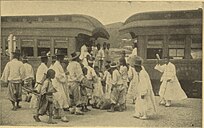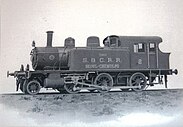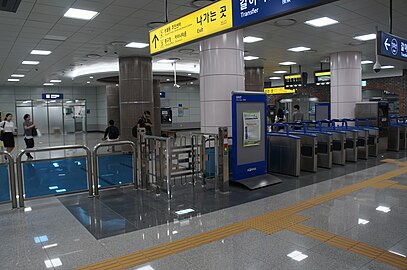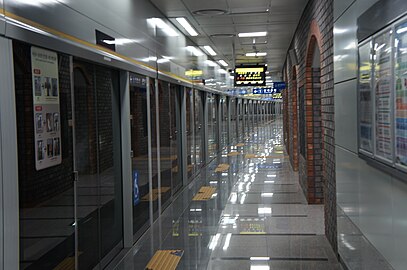Incheon Station
 Incheon Station in 2023 | |||||||||||||||||||||||||
| General information | |||||||||||||||||||||||||
| Location | 3-1 Bukseong-dong 1-ga, 307-2 Jemullyangno, Jung District, Incheon | ||||||||||||||||||||||||
| Coordinates | 37°28′33″N 126°37′01″E / 37.47583°N 126.61694°E | ||||||||||||||||||||||||
| Operated by | |||||||||||||||||||||||||
| Line(s) | Gyeongin Line, Suin–Bundang Line | ||||||||||||||||||||||||
| Platforms | 2 (Line 1) 2 (Suin–Bundang Line) | ||||||||||||||||||||||||
| Tracks | 3 (Line 1) 2 (Suin–Bundang Line) | ||||||||||||||||||||||||
| Bus routes |
| ||||||||||||||||||||||||
| Construction | |||||||||||||||||||||||||
| Structure type | ● Line 1: Aboveground ● Suin-Bundang Line: Underground | ||||||||||||||||||||||||
| History | |||||||||||||||||||||||||
| Opened | September 18, 1899 | ||||||||||||||||||||||||
| Passengers | |||||||||||||||||||||||||
| (Daily) Based on Jan-Dec of 2012. Line 1: 7,642[1] | |||||||||||||||||||||||||
| |||||||||||||||||||||||||
Incheon Station[a] (Korean: 인천역; Hanja: 仁川驛; RR: Incheon-nyeok) is the western terminus railway station of the Suin–Bundang and Gyeongin lines of the Seoul Metropolitan Subway. The station is in the Bukseong neighborhood of the Jung District in Incheon, South Korea and is approximately 20 kilometers west of Seoul.[2]: 115 Established in 1899 under the Korean Empire as Chemulpo Station[b] (제물포역; 濟物浦驛), Incheon Station is the oldest train station in the Seoul Capital Area.[3] During the Japanese occupation of Korea, the station was briefly named Hainchon Station (하인천역; 下仁川驛) and the original station building was destroyed during the Korean War. Service for the Suin Line began in 1937 and ended in 1995. Service for the Gyeongin Line began in 1974 and service on the Suin–Bundang Line began in 2020.
History
In 1896, Gojong of Korea gave the construction rights for a train line from Seoul to Jemulpo to American financier James R. Morse[4] under the condition that it would be returned to the government in 15 years.[5][6][2]: 118 In return, the Korean government provided government land and purchased privately owned land for Morse's company.[7]: 288 This was done in an attempt to keep the station from being appropriated by the Empire of Japan.[5][6][2]: 118 When construction for the railway began in 1897,[7]: 288 the station was originally planned to be built in the Takpo (탁포) area, but complaints from local residents led the Korean government to instead reclaim tidal land by the Incheon port for the station.[7]: 288 In 1899, the company ran out of funds and the rights to the station were sold to the Japanese Gyeongin Railway before construction was finished.[3][6][4] The station opened to the public on September 18, 1899[2]: 118–119 under the name Chemulpo Station[b] (제물포역; 濟物浦驛).[5] The Gyeongin Railway operated trains from Incheon Station to Noryangjin station in Seoul,[5] and the completion of the Hangang Railway Bridge in July 1900 expanded service to Seoul Station.[8]: 278
The construction of the Gyeongin Railway and Incheon Station divided Incheon in half and limited development in the northern half of the city.[7]: 289 Ownership over the station aided Japan during the 1904–5 Russo-Japanese War.[2]: 119 In 1926, the Empire of Japan changed the station name to Hainchon Station (하인천역; 下仁川驛) because of the station's proximity to the Incheon Supervisory Office.[5] In 1937, the Japanese Chosen Railway built the Suin Line to transport salt from the Sorae salt field in Incheon to Suwon.[9] The line continued to operate after liberation until 1995, when the line was discontinued.[9]
On June 1, 1948, the station name was changed to Incheon Station.[10] Incheon Station was destroyed during the Korean War, and a makeshift building was used until the opening of the current station building in September, 1960.[3][6] Services on the Seoul Subway Line 1 began on August 15, 1974. In 2011, the city temporarily rebranded the station as Incheon Station (Chinatown) (Korean: 인천역(차이나타운)).[11]
Freight rail service at Incheon Station ended in 2020 as a result of rising logistics costs and a greater focus on passenger rail service.[12] Deliveries of bituminous coal were redirected to the northern Pohang Station.[12] The rebuilt Suin–Bundang Line began operations on September 12, 2020, and directly connected Suwon to Incheon by rail for the first time in 25 years.[12][9]
On October 8, 2019, a connection was opened between Incheon Station and the Wolmi Sea Train tourist monorail.[13] The city had previously spent 85 billion won in 2009 constructing a connection between the station to Wolmido island, but operations for the line were suspended due to faulty construction.[14]
Location
The station is adjacent to the Incheon Chinatown, which was founded by Chinese merchants who arrived in Incheon's port after it opened to foreign trade in 1883.[6][15][16] The station is also adjacent to Freedom Park, the Incheon Harbor, Wolmido island, and the Songwol-dong Fairy Tale Village.[3]
Seoul blue bus routes 2, 10, 15, 28, and 45, Seoul yellow bus route 307, and Seoul green bus route Incheon e-Eum 1 serve the station.[17]
In popular culture
Incheon Station serves as the background of several shots in the 2001 South Korean romantic comedy film My Sassy Girl'.[18]
Gallery
Notes
References
- ^ Monthly Number of Passengers between Subway Stations Archived 2014-10-06 at the Wayback Machine. Korea Transportation Database, 2013. Retrieved 2013-10-15.
- ^ a b c d e Kyung, Moon Hwang (2022). A History of Korea (3rd ed.). Red Globe Press. ISBN 9781352013023.
- ^ a b c d "Incheon Station". Incheon Jung-gu Culture & Tourism. Jung District, Incheon. Retrieved July 11, 2023.
- ^ a b Kim, Hyung-eun (October 19, 2009). "A dubious achievement". Korea JoongAng Daily. Archived from the original on July 11, 2023. Retrieved July 11, 2023.
- ^ a b c d e 이, 형우 (April 20, 2021). "동인천역은 인천 서쪽에 있는데 왜 동인천일까" [Dong-Incheon (East Incheon) Station is in the west of Incheon so why is it called Dong-Incheon (East Incheon) Station?]. Incheon Today (in Korean). Archived from the original on July 11, 2023. Retrieved July 11, 2023.
- ^ a b c d e Hae-yeon, Kim (September 16, 2021). "Walking through gateway to Korea: Incheon". The Korea Herald. Archived from the original on July 11, 2023. Retrieved July 11, 2023.
- ^ a b c d Choe, Yeong-jun (2005). Land and Life: A Historical Geographical Exploration of Korea. Translated by Sarah, Kim. Jain Publishing Company. ISBN 978-0895818355.
- ^ 고, 종석 (March 10, 2003). 히스토리아. 마음의산책. ISBN 8989351383.
- ^ a b c 김, 민영 (September 17, 2020). "돌아온 수인선, 하나로 이어진 수인분당선!" [The return of the Suin Line, the Suin–Bundang Line that connects into one line!] (in Korean). Ministry of Culture, Sports and Tourism. Archived from the original on May 7, 2023. Retrieved July 11, 2023.
- ^ "仁川驛等改名(인천역등개명)" [Incheon Station and others changed names] (in Korean). The Dong-a Ilbo. June 12, 1948. Archived from the original on July 11, 2023. Retrieved July 11, 2023 – via Naver News Library.
- ^ 김, 성웅 (October 10, 2011). "인천역·차이나타운 역명부기 행사" [Event to name the Incheon Chinatown Station]. Incheon Ilbo (in Korean). Archived from the original on July 11, 2023. Retrieved July 11, 2023.
- ^ a b c 이, 주영 (August 20, 2020). "인천역 화물운송 역사의 뒤안길로" [The history of the decline of cargo transport at Incheon Station]. Incheon Ilbo (in Korean). Archived from the original on July 11, 2023. Retrieved July 11, 2023.
- ^ Cheong-mo, Yoo (October 7, 2019). "Incheon to open seaside monorail line to draw more tourists". Yonhap News Agency. Archived from the original on July 11, 2023. Retrieved July 11, 2023.
- ^ Na, Jeong-ju (April 4, 2012). "In financial pinch, Incheon under pressure to downscale Asiad plan". The Korea Times. Archived from the original on July 11, 2023. Retrieved July 11, 2023.
- ^ Her, Yun-hee (February 27, 2022). "Strolling through history in Incheon's Gaehangjang, the birthplace of jjajangmyeon". The Hankyoreh. Archived from the original on July 11, 2023. Retrieved July 11, 2023.
- ^ Kirk, Don (March 23, 2001). "Inchon: Look on the Bright Side". International Herald Tribune. Archived from the original on July 11, 2023. Retrieved July 11, 2023 – via The New York Times.
- ^ "버스정보시스템". bus.incheon.go.kr. Archived from the original on July 11, 2023. Retrieved July 11, 2023.
- ^ Lee, Hae-joo (September 15, 2009). "Isn't that the train station from 'My Sassy Girl'?". Korea JoongAng Daily. Archived from the original on July 11, 2023. Retrieved July 11, 2023.









